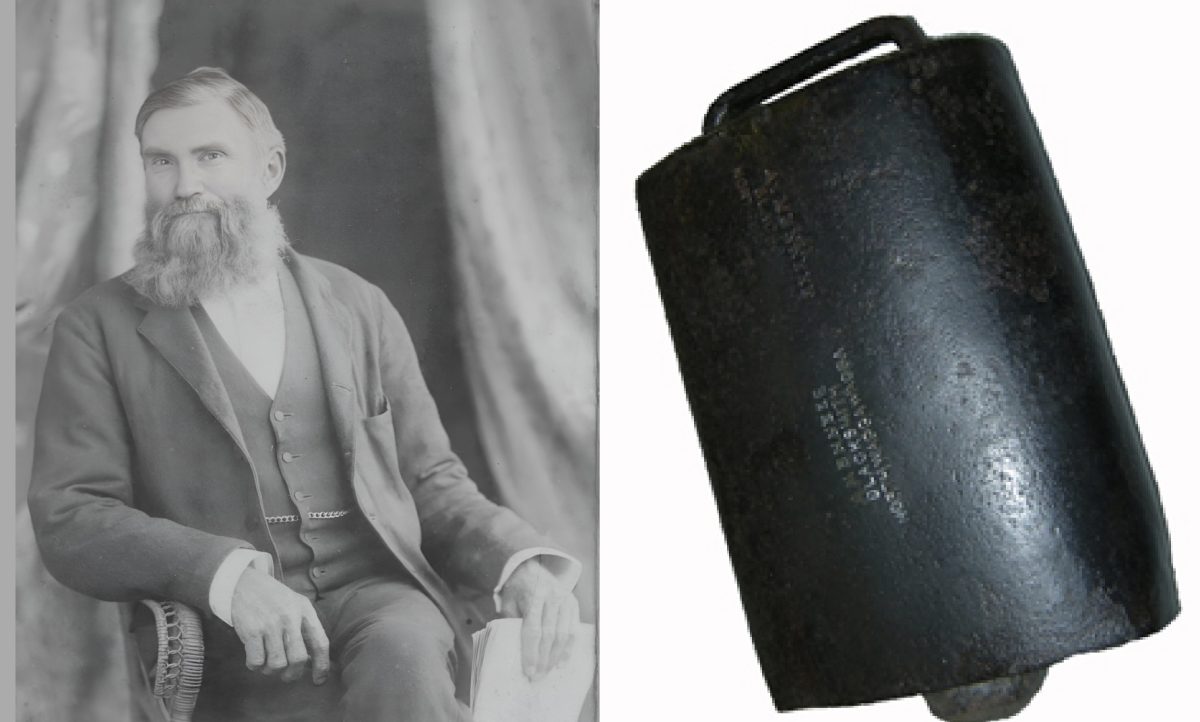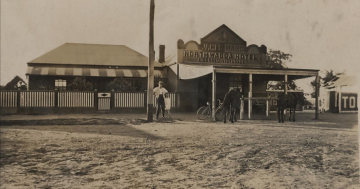
August Menneke and one of the last remaining Wagga Pots in the Museum of the Riverina. Photo: Supplied.
According to Dame Mary Gilmore, North Wagga blacksmith August Menneke “had a perfect ear for the sound of a bell”.
The German migrant and his wife Maria moved to Wagga in 1867 where he set up his forge at North Wagga around 100 metres south of the Black Swan Hotel and a stone’s throw from the river.
Menneke quickly forged a reputation as an excellent wheelwright and blacksmith and his unique brand of livestock bell, the “Wagga Pot”, became highly sought-after for its clear and distinctive sound.
Dame Mary described them as being “small in size and of a tenor quality” and claimed that her uncle had “heard one three miles away on clear, frosty nights”.
She paid tribute to the bullock drivers and the iconic bellmaker in her 1929 poem ‘Bells and Bullocks’, describing an aging teamster thinking back to long-gone days.
Once in a while we ask if he hears
The sound of Menneke’s bells, **
Deep in the pits of his ancient ears
Repeating their olden spells.
“Menneke’s bells? . . .”
Then he’ll say,
“Never heard none like ’em;
Menneke, he had his way;
No-one else could strike ’em.”
Another author, Alan Marshall wrote that “there’s no sweeter music in the bush than the sound of bullock bells on a frosty night”.
He described the pride men took in their bells and quoted one old bullock driver who was settling his team for the night and attached a distinctive bell to the straggler.
“‘It’s a Menneke bell’, the bullocky said ‘and no better bell has ever been made. You can hear it five miles away on a clear night.’”
Menneke’s chief rival was Anthony Mongan of Albury who made a tapering ‘Kentucky shape bell’ and there are claims that they two put their bells to the test on Mt Kosciusko.
When the Wagga Pot was heard at a rumoured distance of 10 miles, Menneke was crowned the best bellmaker in Australia.
Mr DW Cassidy penned a letter to the editor of The Daily Advertiser in November 1947 describing a bell in his possession as being “made of a piece of steel crosscut saw and the joints are fortified with an alloy made principally of brass which gave it the melodious penetrating sound so beloved by Dame Mary”.
The bell cost Mr Cassidy’s father the hefty sum of one guinea and he claimed to have heard the bell “at a distance of six miles while it was on a horse’s neck on the plains in the Hay district”.
While old saw blades served for the early models, Menneke continued to refine his Wagga Pots and exclusively used imported metals from Germany for the later versions.
The smith was so particular that it was said that any bell that did not meet his exacting standards was flung across the road into the Murrumbidgee!
Given the expense of importing metals, this seems unlikely.
When he passed away suddenly of an illness aged just 66 in 1904, Menneke was remembered as a well known and respected resident of North Wagga where he had steadily increased his holdings.
Very few of his iconic bells remain, however, there are two preserved in the Museum of the Riverina.










